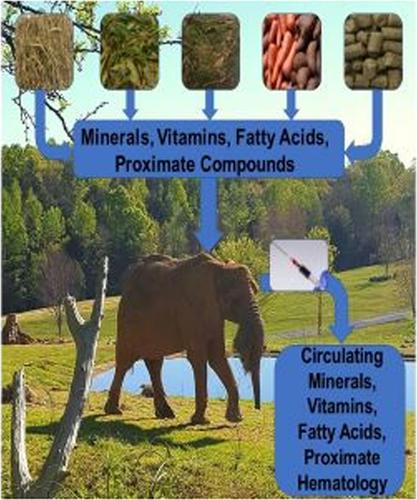Our official English website, www.x-mol.net, welcomes your feedback! (Note: you will need to create a separate account there.)
Circulating nutrients and hematological parameters in managed African elephants ( Loxodonta Africana ) over a 1‐year period
Zoo Biology ( IF 1.3 ) Pub Date : 2020-07-07 , DOI: 10.1002/zoo.21556 Jordan Wood 1 , Elizabeth Koutsos 2 , Corinne J Kendall 3 , Larry J Minter 3 , Troy Tollefson 4 , Erin Ivory 3 , Kimberly Ange-van Heugten 1
Zoo Biology ( IF 1.3 ) Pub Date : 2020-07-07 , DOI: 10.1002/zoo.21556 Jordan Wood 1 , Elizabeth Koutsos 2 , Corinne J Kendall 3 , Larry J Minter 3 , Troy Tollefson 4 , Erin Ivory 3 , Kimberly Ange-van Heugten 1
Affiliation

|
African elephants (Loxodonta Africana) are currently considered a vulnerable species. One key to improving methods of species management is to better monitor and understand elephant nutrition. Analyzing circulating nutrients is one of the best and least invasive methods of monitoring managed elephant nutrition, but limited reference values are available. This study examined the circulating basic hematology concentrations, minerals, vitamins A, D, and E, and fatty acids of six African elephants (two males and four females) at the North Carolina Zoo collected monthly from March 2016 to April 2017 and compared levels among seasons. Creatinine (CRE) and albumin had seasonal differences (p ≤ .05). Calcium, magnesium, phosphorus, potassium, selenium, zinc, cobalt, manganese, and molybdenum displayed seasonal differences (p ≤ .05). Retinol and 25-hydroxyvitamin D2 had seasonal differences (p ≤ .05). Linoleic acid, α-linolenic acid, arachidonic acid, total omega-3 fatty acids, total omega-6 fatty acids, and the omega-6 to omega-3 ratio showed seasonal differences (p ≤ .05). Findings suggest that exogenous vitamin E supplements may not be necessary with a mixed feedstuff diet (hay, fortified concentrate pellet, browse, and produce) based on circulating values. This data offer updated information on circulating reference values and novel circulating concentrations of nutrients for Southeastern US managed African elephants that can be used to inform nutritional and health management in all similar habitats.
中文翻译:

管理的非洲象 (Loxodonta Africana) 1 年内的循环营养物质和血液学参数
非洲象(Loxodonta Africana)目前被认为是一种脆弱的物种。改进物种管理方法的一个关键是更好地监测和了解大象的营养。分析循环营养物质是监测管理大象营养的最佳且侵入性最小的方法之一,但可用的参考值有限。本研究检查了北卡罗来纳动物园 2016 年 3 月至 2017 年 4 月每月收集的六头非洲象(两头雄性和四头雌性)的循环基础血液学浓度、矿物质、维生素 A、D 和 E 以及脂肪酸,并比较了它们之间的水平。季节。肌酐 (CRE) 和白蛋白具有季节性差异 (p ≤ .05)。钙、镁、磷、钾、硒、锌、钴、锰和钼显示出季节性差异 (p ≤ .05)。视黄醇和 25-羟基维生素 D2 具有季节性差异 (p ≤ .05)。亚油酸、α-亚麻酸、花生四烯酸、总 omega-3 脂肪酸、总 omega-6 脂肪酸以及 omega-6 与 omega-3 的比例显示出季节性差异 (p ≤ .05)。研究结果表明,根据循环值,混合饲料日粮(干草、强化浓缩颗粒、饲料和农产品)可能不需要外源性维生素 E 补充剂。该数据提供了有关美国东南部管理的非洲象的循环参考值和新的营养循环浓度的最新信息,可用于为所有类似栖息地的营养和健康管理提供信息。并且 omega-6 与 omega-3 的比例显示出季节性差异(p ≤ .05)。研究结果表明,根据循环值,混合饲料日粮(干草、强化浓缩颗粒、饲料和农产品)可能不需要外源性维生素 E 补充剂。该数据提供了有关美国东南部管理的非洲象的循环参考值和新的营养循环浓度的最新信息,可用于为所有类似栖息地的营养和健康管理提供信息。并且 omega-6 与 omega-3 的比例显示出季节性差异(p ≤ .05)。研究结果表明,根据循环值,混合饲料日粮(干草、强化浓缩颗粒、饲料和农产品)可能不需要外源性维生素 E 补充剂。该数据提供了有关美国东南部管理的非洲象的循环参考值和新的营养循环浓度的最新信息,可用于为所有类似栖息地的营养和健康管理提供信息。
更新日期:2020-07-07
中文翻译:

管理的非洲象 (Loxodonta Africana) 1 年内的循环营养物质和血液学参数
非洲象(Loxodonta Africana)目前被认为是一种脆弱的物种。改进物种管理方法的一个关键是更好地监测和了解大象的营养。分析循环营养物质是监测管理大象营养的最佳且侵入性最小的方法之一,但可用的参考值有限。本研究检查了北卡罗来纳动物园 2016 年 3 月至 2017 年 4 月每月收集的六头非洲象(两头雄性和四头雌性)的循环基础血液学浓度、矿物质、维生素 A、D 和 E 以及脂肪酸,并比较了它们之间的水平。季节。肌酐 (CRE) 和白蛋白具有季节性差异 (p ≤ .05)。钙、镁、磷、钾、硒、锌、钴、锰和钼显示出季节性差异 (p ≤ .05)。视黄醇和 25-羟基维生素 D2 具有季节性差异 (p ≤ .05)。亚油酸、α-亚麻酸、花生四烯酸、总 omega-3 脂肪酸、总 omega-6 脂肪酸以及 omega-6 与 omega-3 的比例显示出季节性差异 (p ≤ .05)。研究结果表明,根据循环值,混合饲料日粮(干草、强化浓缩颗粒、饲料和农产品)可能不需要外源性维生素 E 补充剂。该数据提供了有关美国东南部管理的非洲象的循环参考值和新的营养循环浓度的最新信息,可用于为所有类似栖息地的营养和健康管理提供信息。并且 omega-6 与 omega-3 的比例显示出季节性差异(p ≤ .05)。研究结果表明,根据循环值,混合饲料日粮(干草、强化浓缩颗粒、饲料和农产品)可能不需要外源性维生素 E 补充剂。该数据提供了有关美国东南部管理的非洲象的循环参考值和新的营养循环浓度的最新信息,可用于为所有类似栖息地的营养和健康管理提供信息。并且 omega-6 与 omega-3 的比例显示出季节性差异(p ≤ .05)。研究结果表明,根据循环值,混合饲料日粮(干草、强化浓缩颗粒、饲料和农产品)可能不需要外源性维生素 E 补充剂。该数据提供了有关美国东南部管理的非洲象的循环参考值和新的营养循环浓度的最新信息,可用于为所有类似栖息地的营养和健康管理提供信息。


























 京公网安备 11010802027423号
京公网安备 11010802027423号